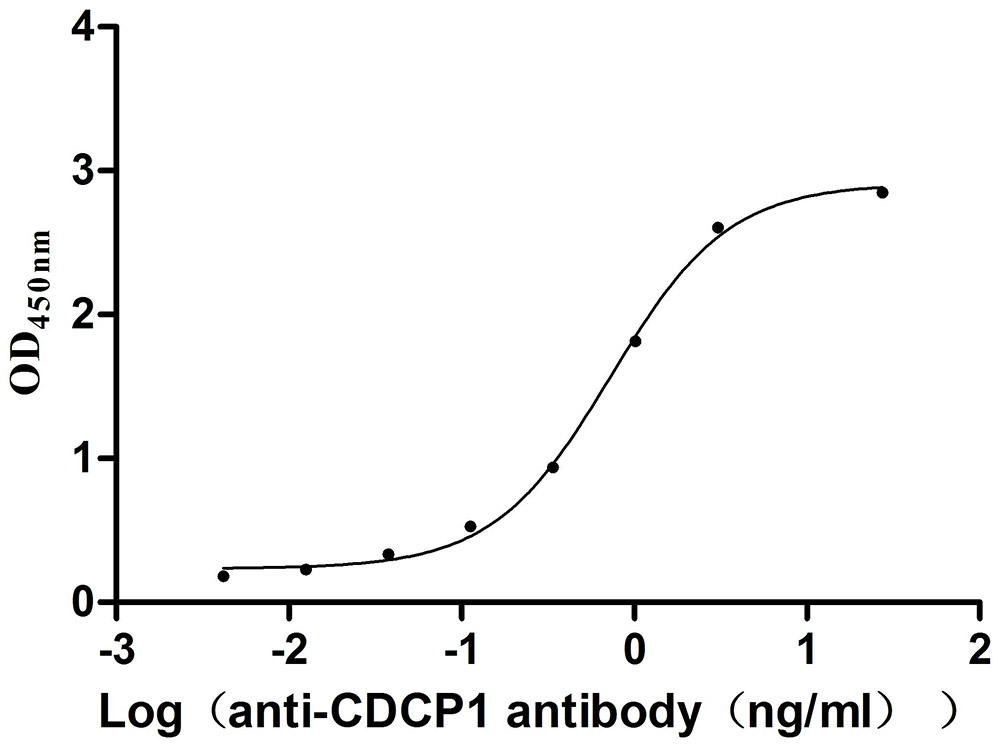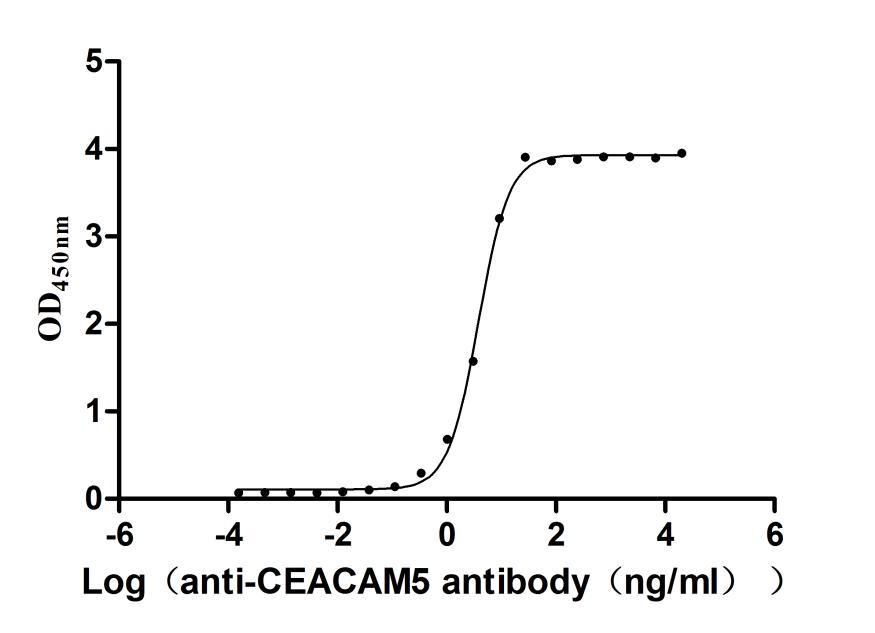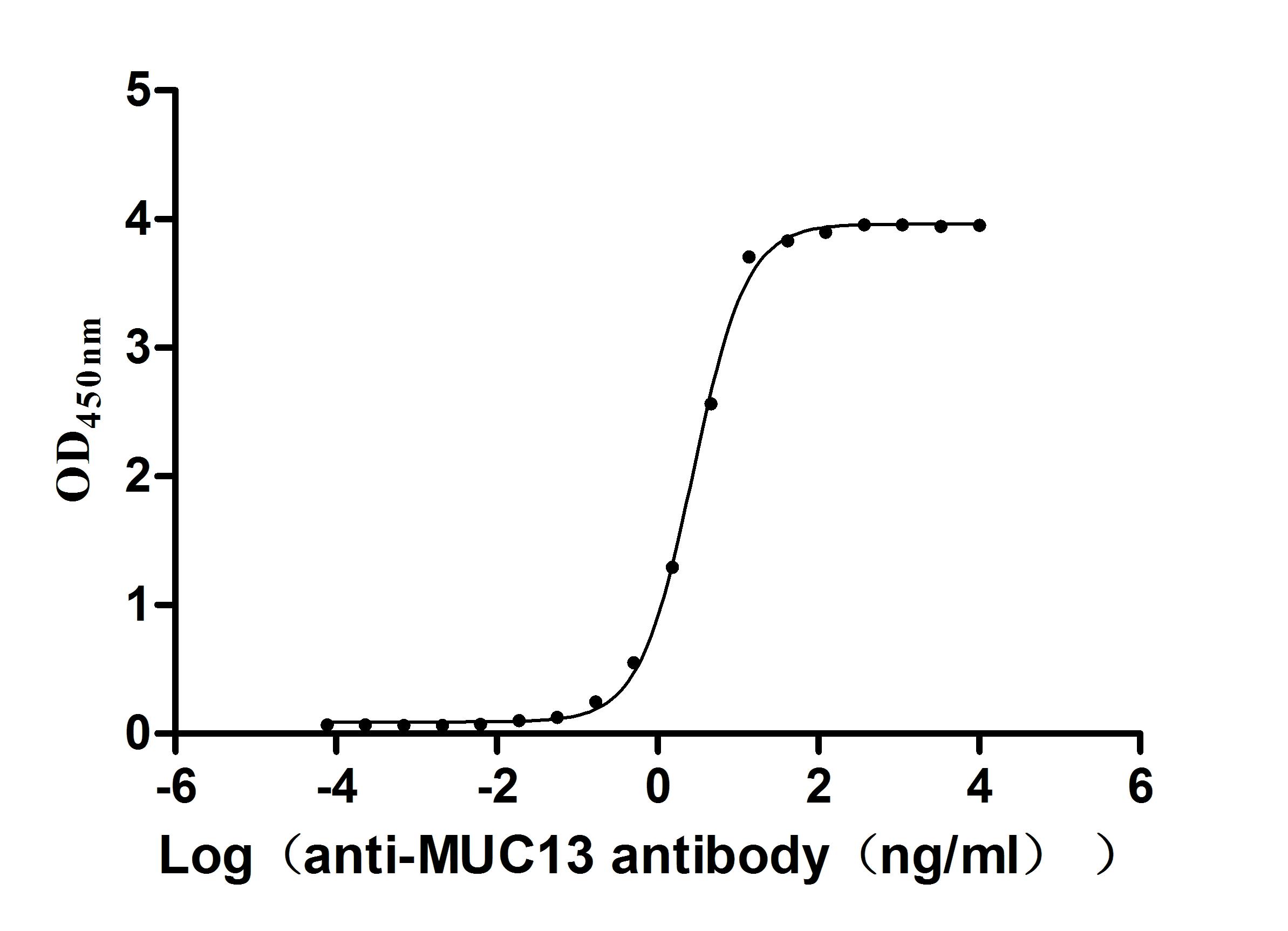Recombinant Human Sodium-dependent serotonin transporter (SLC6A4), partial
-
货号:CSB-YP021702HU
-
规格:
-
来源:Yeast
-
其他:
-
货号:CSB-EP021702HU
-
规格:
-
来源:E.coli
-
其他:
-
货号:CSB-EP021702HU-B
-
规格:
-
来源:E.coli
-
共轭:Avi-tag Biotinylated
E. coli biotin ligase (BirA) is highly specific in covalently attaching biotin to the 15 amino acid AviTag peptide. This recombinant protein was biotinylated in vivo by AviTag-BirA technology, which method is BriA catalyzes amide linkage between the biotin and the specific lysine of the AviTag.
-
其他:
-
货号:CSB-BP021702HU
-
规格:
-
来源:Baculovirus
-
其他:
-
货号:CSB-MP021702HU
-
规格:
-
来源:Mammalian cell
-
其他:
产品详情
-
纯度:>85% (SDS-PAGE)
-
基因名:SLC6A4
-
Uniprot No.:
-
别名:5 HTT; 5 HTTLPR; 5 hydroxytryptamine (serotonin) transporter; 5 hydroxytryptamine transporter; 5HT transporter; 5HTT; hSERT; HTT; Na+/Cl- dependent serotonin transporter; OCD1; SC6A4_HUMAN; Serotonin transporter 1; SERT; SERT1; Slc6a4; Sodium dependent serotonin transporter; Sodium-dependent serotonin transporter; Solute carrier family 6 (neurotransmitter transporter) member 4; solute carrier family 6 (neurotransmitter transporter; serotonin); member 4; Solute carrier family 6 member 4
-
种属:Homo sapiens (Human)
-
蛋白长度:Partial
-
蛋白标签:Tag type will be determined during the manufacturing process.
The tag type will be determined during production process. If you have specified tag type, please tell us and we will develop the specified tag preferentially. -
产品提供形式:Lyophilized powder
Note: We will preferentially ship the format that we have in stock, however, if you have any special requirement for the format, please remark your requirement when placing the order, we will prepare according to your demand. -
复溶:We recommend that this vial be briefly centrifuged prior to opening to bring the contents to the bottom. Please reconstitute protein in deionized sterile water to a concentration of 0.1-1.0 mg/mL.We recommend to add 5-50% of glycerol (final concentration) and aliquot for long-term storage at -20℃/-80℃. Our default final concentration of glycerol is 50%. Customers could use it as reference.
-
储存条件:Store at -20°C/-80°C upon receipt, aliquoting is necessary for mutiple use. Avoid repeated freeze-thaw cycles.
-
保质期:The shelf life is related to many factors, storage state, buffer ingredients, storage temperature and the stability of the protein itself.
Generally, the shelf life of liquid form is 6 months at -20°C/-80°C. The shelf life of lyophilized form is 12 months at -20°C/-80°C. -
货期:Delivery time may differ from different purchasing way or location, please kindly consult your local distributors for specific delivery time.Note: All of our proteins are default shipped with normal blue ice packs, if you request to ship with dry ice, please communicate with us in advance and extra fees will be charged.
-
注意事项:Repeated freezing and thawing is not recommended. Store working aliquots at 4°C for up to one week.
-
Datasheet :Please contact us to get it.
相关产品
靶点详情
-
功能:Serotonin transporter whose primary function in the central nervous system involves the regulation of serotonergic signaling via transport of serotonin molecules from the synaptic cleft back into the pre-synaptic terminal for re-utilization. Plays a key role in mediating regulation of the availability of serotonin to other receptors of serotonergic systems. Terminates the action of serotonin and recycles it in a sodium-dependent manner.
-
基因功能参考文献:
- platelet 5-HT content and SERT as peripheral surrogates in depression and anxiety patients PMID: 30031795
- The relationship between bullying and pain was modified by genetic variation in the promotor region of SLC6A4. Study data indicated that the effect of bullying on health and well-being is dependent on a gene-environment interaction. PMID: 29313869
- This study showed an interaction exists in which the S allele of 5-HTTLPR increases risk of depression only in stressed individuals. PMID: 28373689
- STin2 VNTR polymorphism of SLC6A4 gene may contribute to Crohn's disease pathogenesis. PMID: 30394015
- 5HTTLPR and dating violence victimization interact to increase odds of marijuana use. PMID: 30049530
- ECs derived miR-195 acts as a new regulator to modulate the expression of 5-HTT in SMCs. PMID: 28272473
- rs591323 had the effect on SERT availability of pons in healthy male subjects, not in female subjects. SERT availability of AA genotype of rs591323 was lower than those of the other 2 genotypes. However, SNPs of risk loci for Parkinson's disease did not show any effect on DAT availability. PMID: 29774458
- platelet BDNF and SERT do not specifically underlie psychosocial deficits in stage Huntington's Disease PMID: 30039833
- SLC6A4 l/l carriers have a better ability to perceive and focus their attention on the elements of their environment and to have the capacity to understand and predict what will happen with those elements. PMID: 29298559
- 5-HTTLPR's variant moderates Adolescent Substance Misuse Initiation. PMID: 27861757
- High serotonin and SERT levels may indicate that these biomarkers have a role in the autism pathogenesis and support the possibility of using serotonin and SERT to diagnose autism severity PMID: 29738009
- Findings indicated that the SERT insertion/deletion polymorphism may serve as a genetic biomarker of irritable bowel syndrome in Asians and Caucasians. [meta-analysis] PMID: 30121382
- results showing strong associations of childhood neglect and abuse and significant effects of the low-expressing alleles (S; L G ) of 5-HTTLPR with alexithymia. PMID: 29306941
- Alcohol use may be positively related, at least cross-sectionally, to depressive symptoms in female carriers of the 5-HTTLPR S allele, and indicate that moderators such as SLC6A4 genotype and sex need to be taken into account when examining associations between depressive symptoms and drinking behavior. PMID: 29220746
- The SERT gene promoter SNP rs25531 was associated with the cancer-related fatigue in patients with colon and rectal cancer PMID: 29551185
- No differences were found between murderers and thieves either concerning 5HTTLPR and 5-HT2C genotypes or concerning psychological measures. Comparison of polymorphism distribution between groups of prisoners and controls revealed highly significant associations of 5HTTLPR and 5-HTR2C (rs6318) gene polymorphisms with being convicted for criminal behavior. PMID: 29621775
- Significant association was observed between the S/S genotype of the SLC6A4 polymorphism and globus pharyngeus, suggesting that SLC6A4 is a potential candidate gene involved in the pathogenesis of globus pharyngeus. PMID: 29310115
- Association of SLC6A4 variants with familial form of OCD. PMID: 28691545
- 5-HTTLPR genotype was associated with traffic behaviour: The S'-allele carriers had significantly lower odds for speeding offences and traffic accidents. The lower prevalence of S'-allele carriers among those who had committed speeding offences was statistically significant in females, while the lower prevalence of having been involved in a traffic accident was rather observed in males. PMID: 29407665
- In the present study we systematically investigated the contribution of SNPs toward Social anxiety disorder by performing genotyping of 24 SNPs that have been reported previously in SAD or other psychiatric disorders. This showed an association between rs140701 at SLC6A4 and SAD, especially in Social anxiety disorder patients without panic disorder. PMID: 28272115
- Functional network-based phenotype links genetic variation in 5-HTTLPR to emotion regulation. PMID: 28589968
- These findings indicate that TPH1, TPH2, and SLC6A4 variants moderate the subjective effects of cocaine in non-treatment-seeking cocaine-dependent participants. PMID: 28590957
- This study found that the SLC6A4 hyper-methylation and hypo-expression was found in healthy subjects with childhood trauma. PMID: 29056292
- resilience fully mediated the association between the S 5-HTTLPR allele and depression in the medically ill. PMID: 28903099
- Study applied graph theory analysis on resting-state fMRI of 120 women selected based on neuroticism score, & genotyped 2 polymorphisms: 5-HTTLPR (S-carriers and L-homozygotes) and COMT (rs4680-rs165599; COMT risk group and COMT non-risk group). For the 5-HTTLPR polymorphism, found that subnetworks related to cognitive control show less connections with other subnetworks in S-carriers compared to L-homozygotes. PMID: 27743374
- The nursing diagnoses of risk for suicide and imbalanced nutrition are reported less often in 5-HTTLPR homozygotes of the high-expressing gene (LA). Carriers of the low-expressing genes (LG or S) have a worse response to interventions which aim to increase low self-esteem, indicating that they may need more intensive care in order to achieve the desired outcome. PMID: 29016262
- Pilot study demonstrated an increase in the SLC6A4 promoter DNA methylation levels in the saliva of children and adolescents with obsessive-compulsive disorder. DNA methylation provides one important epigenetic mechanism through which environmental influences can affect psychiatric disease risk. PMID: 29102815
- genetic association studies in population in Spain: Data suggest genetic polymorphisms in SLC6A4 promoter region are associated with ability to control food intake in overweight/obese subjects while in weight loss programs; SLC6A4 promoter polymorphisms interact with emotional eating to modulate weight loss. The biggest challenge for losing weight is the ability to control the amount of food eaten. PMID: 28766852
- findings suggest that the 5-HTTLPR S allele is associated with lower BMD in adults younger than 50 years PMID: 28892067
- Depression remitted 5-HTTLPR S/Lg-carriers who experienced childhood trauma automatically avoided sad facial expressions relatively more than LaLa homozygotes with childhood trauma. Remitted LaLa-carriers who had not experienced childhood trauma, avoided sad faces relatively more than LaLa homozygotes with childhood trauma. Study did not find a main effect of childhood trauma. PMID: 29547643
- In a study of the genetic association between polymorphisms in the DAT1, SERT, COMT and BDNF genes and attention deficit and hyperactive disorder, transmission disequilibrium test analysis showed that no individual allele of any variant studied has a preferential transmission PMID: 29122229
- Participants who assessed themselves with greater interdependence reported lower death anxiety/depression and showed decreased neural response to death-related words in emotion-related brain regions including the anterior cingulate, putamen, and thalamus. However, these results were evident in long/long allele carriers of the 5-HTTLPR but not in short/short allele carriers. PMID: 28921740
- 5-HTTLPR S-allele carriers showed a more negative relation between stress exposure and connectivity of the executive control network than L-allele homozygotes, specifically in the pre/postcentral gyrus, striatum, and frontal pole. In the default mode network, found a positive association between the GxE and supramarginal gyrus connectivity. PMID: 27738993
- Study found a significant interaction effect of the serotonin transporter-linked polymorphic region (5-HTTLPR) and the polymorphism in the serotonin 1A receptor gene (rs6295) on the connectivity within the right frontoparietal network, specifically in the middle frontal gyrus and inferior parietal lobule. Mean connectivity in the right inferior parietal lobule was positively correlated with working memory performance. PMID: 28793232
- SIDS is associated with peripheral abnormalities in the 5-HT pathway: compared with postmortem infant SIDS and postmortem infant control samples, living infant controls had higher concentrations of serum 5-HT and lower concentrations of 5-HIAA PMID: 28674018
- Findings support the relevance of peripheral SLC6A4 promoter DNA methylation for frontal-limbic brain processes in healthy individuals, and provided some support for convergence across blood, saliva and epithelial tissues. Buccal epithelial cells may be most sensitive surrogate samples in DNA methylation studies to detect frontal-limbic brain associations. PMID: 28774705
- The 5-HTTLPR polymorphism was associated with the rate of achievement of remission and tolerability of treatment: carriers of the SS genotype achieved remission less frequently and more frequently experienced side-effects. PMID: 27029447
- A significant 5-HTTLPRxearly adversity interaction indicated that greater early adversity was associated with lower latent trait cortisol levels, but only among individuals with either L/L or S/L genotype. Findings suggest that serotonergic genetic variation may influence the impact of early adversity on individual differences in hypothalamic-pituitary-adrenal axis regulation. PMID: 28757071
- 5-HTTLPR and childhood adversity are associated with the personality trait openness to experience. PMID: 28800511
- These data suggest that the carriage of the short form of the 5-HTTLPR may negate the protective effect of psychological resilience against in patient wit depression. PMID: 28774788
- Study shows that individuals homozygous for the long allele of the 5-HTTLPR gene respond to stressful events by reappraising their emotional meaning, which may hamper the harmful effect of stress on mental health. PMID: 28901577
- The 5-HTTLPR polymorphism was associated with neuroticism in women with Premenstrual Dysphoric Disorder. There is more evidence for a role of SERT polymorphisms in Postpartum Depression. PMID: 29082433
- Study suggests that epigenetic mechanisms rather than 5-HTTLPR alone influence in vivo human serotonin transporter (5-HTT) availability. PMID: 28675387
- SERT binding in the diencephalon is reduced in insulin-resistant subjects independently of body weight, while hypothalamic SERT binding tends to be lower in obesity, with no difference between insulin-resistant and insulin-sensitive subjects. This suggests that the metabolic perturbations associated with obesity independently affect SERT binding within the diencephalon. PMID: 27626923
- The current meta-analysis provides new evidence for the robustness of the interaction between stress and 5-HTTLPR in depression. PMID: 29031184
- Serotonin transporter (5-HTT) is responsible for removing serotonin from the synaptic cleft, returning it to the presynaptic neuron, thereby determining the extent, duration and spatial domain of the serotonergic activation. PMID: 26860734
- Study found that S-carriers, relative to LL-homozygous individuals, showed increased magnetoencephalography gamma band power within the amygdala for the late amygdala response to fearful expressions (i.e., after information had been processed within superior temporal sulcus) and not for the early response. PMID: 28580622
- It is unlikely that the investigated genetic variants are clinically relevantly associated with depression after diagnosis of cancer. PMID: 28590587
- Studied association of aggression and 5-HTTLPR, 5HTR1A, and 5HTR2A genetic polymorphisms in industrial Russian and traditional Tanzanian population groups. PMID: 29661255
- the allelic distribution of solute carrier family-6 member-4 promoter region in Turkish athletes, is reported. PMID: 28719342
显示更多
收起更多
-
亚细胞定位:Cell membrane; Multi-pass membrane protein. Endomembrane system; Multi-pass membrane protein. Endosome membrane; Multi-pass membrane protein. Cell junction, synapse. Cell junction, focal adhesion.
-
蛋白家族:Sodium:neurotransmitter symporter (SNF) (TC 2.A.22) family, SLC6A4 subfamily
-
组织特异性:Expressed in platelets (at protein level).
-
数据库链接:
HGNC: 11050
OMIM: 103780
KEGG: hsa:6532
STRING: 9606.ENSP00000261707
UniGene: Hs.134662
Most popular with customers
-
Recombinant Human Signal transducer CD24 (CD24)-Nanoparticle (Active)
Express system: Mammalian cell
Species: Homo sapiens (Human)
-
Recombinant Human Desmoglein-3 (DSG3), partial (Active)
Express system: Baculovirus
Species: Homo sapiens (Human)
-
Recombinant Human Claudin-3 (CLDN3)-VLPs (Active)
Express system: Mammalian cell
Species: Homo sapiens (Human)
-
Recombinant Human Early activation antigen CD69 (CD69), partial (Active)
Express system: Mammalian cell
Species: Homo sapiens (Human)
-
Recombinant Mouse CUB domain-containing protein 1 (Cdcp1), partial (Active)
Express system: Mammalian cell
Species: Mus musculus (Mouse)
-
Recombinant Human Myosin regulatory light chain 12A (MYL12A) (Active)
Express system: E.coli
Species: Homo sapiens (Human)
-
Express system: Mammalian cell
Species: Macaca mulatta (Rhesus macaque)
-
Recombinant Human Mucin-13(MUC13),partial (Active)
Express system: yeast
Species: Homo sapiens (Human)




















